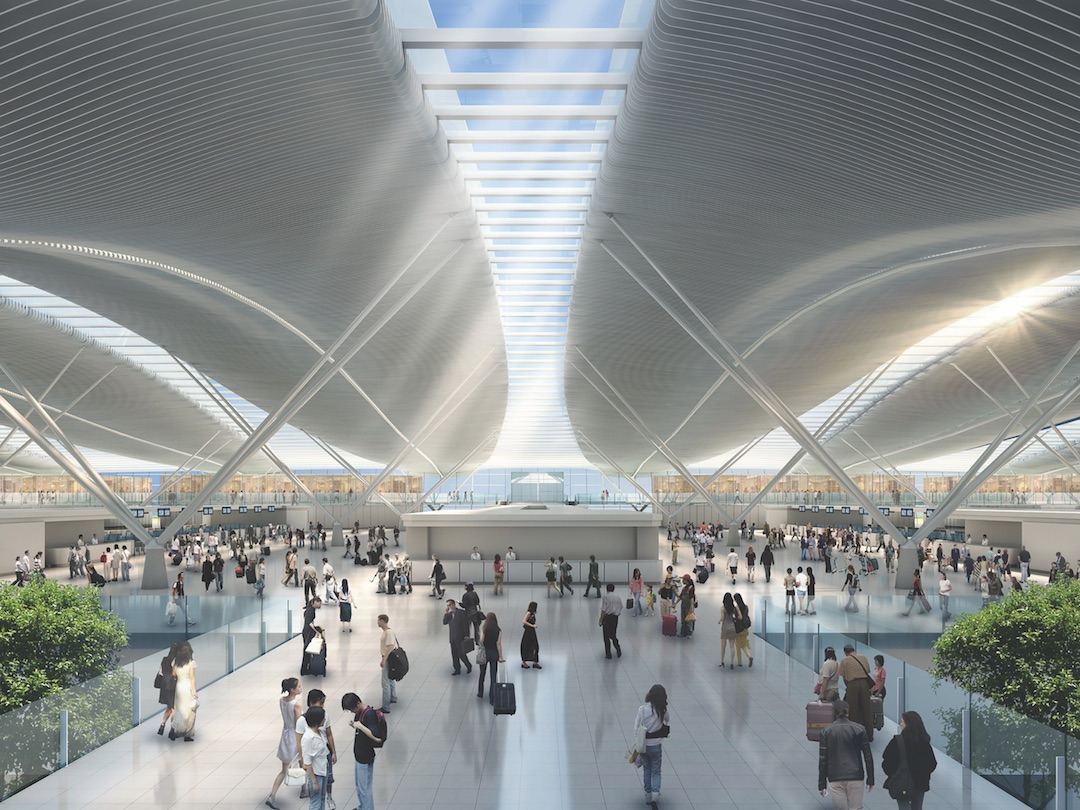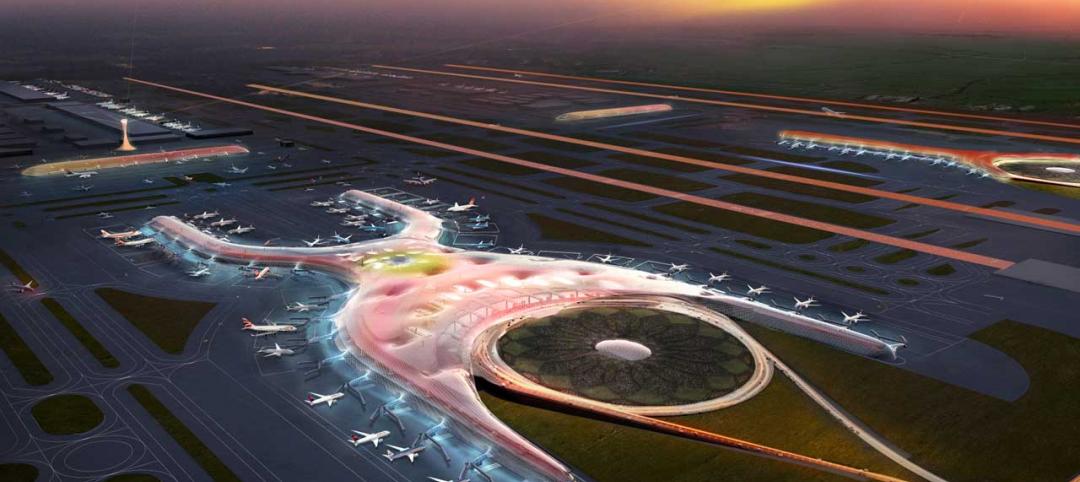Domestic and foreign airlines serving the U.S. carried an all-time high of 965 million passengers in 2017, according to the U.S. Department of Transportation. Airports Council International estimates that 8.8 billion flyers used airports worldwide last year, up 6.6%.
Airport operators everywhere are scrambling to keep pace. “Construction and expansion of airports is growing at a rate of 5–10% or more around the world,” says Jay Fraser, Vice President/General Manager of Turner Construction’s Aviation Group. Turner is adding a three-level, 50,500-sm international port at Cam Ranh International Terminal in Vietnam to handle 2.5 million passengers a year.
Turner and PLC Construction Services are working on the Federal Inspection Services (FIS) Relocation and Expansion project at San Diego International Airport’s Terminal 2 West, which will house Customs and Border Protection services.
U.S. AEC aviation-sector firms are benefiting from the high level of deferred investment in infrastructure, airline profitability, and the strength of the dollar, note Keith Thompson and Terence Young, Principals in Gensler’s Los Angeles office.
See also: Top 45 Airport Facilities Architecture + AE Firms - 2018 Giants 300 rankings
See also: Top 55 Airport Facilities Engineering + EA Firms - 2018 Giants 300 rankings
See also: Top 55 Airport Facilities Contractors + CM Firms - 2018 Giants 300 rankings
Skidmore, Owings & Merrill is lead designer for the new 450,000-sf International Arrivals Facility at Seattle-Tacoma International Airport. It will add eight gates for widebody aircraft and 50 more passport checkbooths and kiosks.
AEC firms that practice design-build or integrated design delivery methods and are open to public-private partnerships are in the sweet spot for airport projects. “Clients are looking at delivery models that save money and time,” says Bijan Pashanamaei, PE, Director of AECOM Global Aviation.
He notes that the design and build portions for the modernization of Phoenix Sky Harbor International Airport’s Terminal 3 were wrapped into a single contract that included DWL Architects + Planners, SmithGroupJJR, and Corgan.
AEC firms are using quicker delivery methods incorporating modular and prefabricated components. “Many clients start with the desire for modular construction," meaning offsite assembly to minimize on-site disruption to ongoing operations, says SOM Director Derek Moore. “This makes sense at very busy airports with little elbow room for traditional construction.”
Mortenson Construction used “substantial fabrication” to deliver an Alternate Utility Facility to support Port of Seattle’s SeaTac airport in the case of disruptive high-wind events, says Mark Baughmam, DBIA, LEED AP, a Construction Executive with Mortenson.
using technology to ease travel anxiety
Turner's Jay Fraser calls technology “the most critical design advancement” for airports. At the FIS facility in San Diego, interactive wayfinding displays and self-boarding gates that
enable planes to load without attendants are being installed.
One new feature at airport gates is a “hearing loop,” which wirelessly transmits boarding announcements to hearing-impaired passengers via their hearing aids or cochlear implants.
“The expectation of technology continues to grow project to project,” says Michael C. Braun, AIA, LEED AP, Executive Vice President with DWL. “Almost every seat has access to power, and the Wi-Fi has excellent coverage. The design must integrate these components in a way that allows them to operate without undermining the architectural features.”
shopping malls with planes
Airports are also revving up their retail and food services. “Unlike struggling malls, airports have a constant source of potential shoppers,” says Kelsey Chesney, Vice President and Senior Brand Strategist, FRCH Design Worldwide.
The design of travel retail has been shifting from a purely efficient, commodity-based model to a targeted, experienced-based one, says Kevin Horn, LEED GA, CallisonRTKL’s Vice President. Airport store designs are showcasing unique local merchandise. “Shop-in-shop” layouts highlight brands and allow flyers to engage products physically and digitally.
Horn notes that some travelers actually route their trips through two of his firm’s recent projects—Inchon International Airport in South Korea and Changi International in Singapore—to take advantage of their expansive retail offerings.
Airports, says Chesney, are becoming “self-contained cities” and homes away from home for frequent flyers. Fitness and wellness centers are popping up in airports. SOM’s Moore is seeing children’s play areas, ubiquitous electrical outlets, premium lounges, and short-term sleeping rooms.
See Also: Retail's age of experimentation
“Adding seasonal outdoor spaces post security, interior landscaping and water features, and commissioned works of art are fast developing as distinguishing features of terminal design to create a sense of place,” says Moore.
In some of its recent airport projects, Gensler has introduced a town square concept that offers spaces for concerts, fashion shows, dance presentations, and local artists’ exhibits, along with meditation and yoga rooms.
This “sense of place” extends to how an airport building is positioned vis-à-vis its outdoor surroundings. DWL’s design for Scottsdale (Ariz.) Airport’s new 23,898-sf Aviation Business Center, says Braun, integrates shaded glass façades to enhance visitors' views of the nearby McDowell Mountains.
This $27 million Terminal Area Redevelopment project, which will expand two hangars, is transforming Scottsdale Airport from a corporate, general aviation reliever facility into "a community resource and a point of pride for the city,” says Braun.
Related Stories
| Oct 16, 2014
Perkins+Will white paper examines alternatives to flame retardant building materials
The white paper includes a list of 193 flame retardants, including 29 discovered in building and household products, 50 found in the indoor environment, and 33 in human blood, milk, and tissues.
| Oct 12, 2014
AIA 2030 commitment: Five years on, are we any closer to net-zero?
This year marks the fifth anniversary of the American Institute of Architects’ effort to have architecture firms voluntarily pledge net-zero energy design for all their buildings by 2030.
| Sep 24, 2014
Architecture billings see continued strength, led by institutional sector
On the heels of recording its strongest pace of growth since 2007, there continues to be an increasing level of demand for design services signaled in the latest Architecture Billings Index.
| Sep 22, 2014
4 keys to effective post-occupancy evaluations
Perkins+Will's Janice Barnes covers the four steps that designers should take to create POEs that provide design direction and measure design effectiveness.
| Sep 22, 2014
Sound selections: 12 great choices for ceilings and acoustical walls
From metal mesh panels to concealed-suspension ceilings, here's our roundup of the latest acoustical ceiling and wall products.
| Sep 15, 2014
Ranked: Top international AEC firms [2014 Giants 300 Report]
Parsons Brinckerhoff, Gensler, and Jacobs top BD+C's rankings of U.S.-based design and construction firms with the most revenue from international projects, as reported in the 2014 Giants 300 Report.
| Sep 9, 2014
Using Facebook to transform workplace design
As part of our ongoing studies of how building design influences human behavior in today’s social media-driven world, HOK’s workplace strategists had an idea: Leverage the power of social media to collect data about how people feel about their workplaces and the type of spaces they need to succeed.
| Sep 8, 2014
First Look: Foster + Partners, Fernando Romero win competition for Mexico City's newest international airport
Designed to be the world’s most sustainable airport, the plan uses a single, compact terminal scheme in lieu of a cluster of buildings, offering shorter walking distances and fewer level changes, and eliminating the need for trains and tunnels.
| Sep 3, 2014
New designation launched to streamline LEED review process
The LEED Proven Provider designation is designed to minimize the need for additional work during the project review process.
| Sep 2, 2014
Ranked: Top green building sector AEC firms [2014 Giants 300 Report]
AECOM, Gensler, and Turner top BD+C's rankings of the nation's largest green design and construction firms.
















